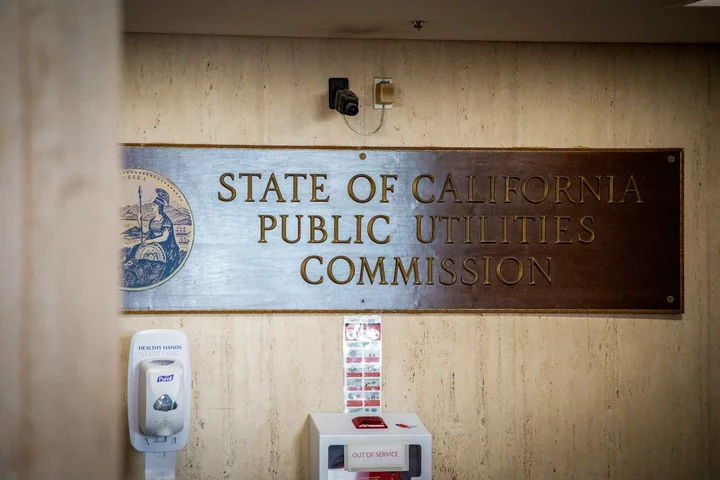The California Public Utilities Commission offices at the Edmund G. Pat Brown building in San Francisco on Jan. 28, 2022. Photo by Martin do Nascimento, CalMatters
###
A day before the California Public Utilities Commission was to vote on a rule that would have shrunken subsidies low-income residents use for phone and internet services, officials pulled the item from the commission’s agenda.
Under the proposed rule, low-income California households who qualify for federal help to pay for phone service and internet access would have lost some or all of their California LifeLine monthly discounts. The result: Instead of being able to stack three discounts, most California LifeLine users would have been limited to two, for a total of up to $39.25 in discounts a month.
The commission was scheduled to discuss and vote on the proposal at its meeting Thursday but officials removed it from the agenda without a written explanation. A commission spokesperson did not respond to requests for comment.
The withdrawal comes after months of objections and mounting pressure from state legislators, LifeLine provider companies, and ordinary Californians who submitted 38 public comments to the commission.
The California LifeLine program provides discounts to low-income households for phone and internet services. It is similar to and sometimes is used with the federal Lifeline program.
In August, Assemblymember Sharon Quirk-Silva, a Buena Park Democrat, and eight other legislators sent a letter to the commission urging it to amend the proposal.
“This proposed decision would make critically needed broadband services for potentially millions of low-income Californians harder to afford at a time when they are struggling from the harmful impacts of the pandemic and record inflation,” Quirk-Silva wrote.
The bipartisan group of Assembly members also expressed concern in the letter about the commission’s analysis of its new rule, which claims that 6 gigabytes of wireless data is sufficient for low-income Californians.
By contrast, the average smartphone user in the United States used 11GB or more each month in 2020, according to Ericsson, a Swedish telecommunications company.
Costs of staying connected
Similarly more than 8,000 Californians signed an online petition urging the commission to allow residents to receive unlimited wireless connectivity with all three state and federal discounts.
Until March of this year, low-income families were able to leverage up to $75 a month in discounts from a combination of three subsidies. They could “stack” two federal subsidies and one California LifeLine subsidy to pay for phone and internet.
In May 2021, the federal government created the Emergency Broadband Benefit, a $50-per-month subsidy to support families struggling to stay connected in the pandemic. The government phased out the program late last year and replaced it with the Affordable Connectivity Plan, a slightly slimmer discount of $30 a month.
‘This proposed decision would make critically needed broadband services for … low-income Californians harder to afford at a time when they are struggling from the harmful impacts of the pandemic and record inflation.’
— Assemblymember Sharon Quirk-Silva, Democrat from Buena Park
At the same time, California’s LifeLine program provided a $16.23 per month discount for low-income households.
Currently consumers are able to apply the Affordable Connectivity discount and one LifeLine plan per household, either the state or the national LifeLine plan.
The proposed rule would have permanently cut the amount of California LifeLine subsidies to $9.25 for a family that also receives federal support, giving them a maximum of $39.25 a month.
But now with the plan withdrawn, the commission has a number of options moving forward, said supporters of the rule. It can make revisions to the proposal, propose a new one, or not vote on one at all.
Under current rules set by the commission, LifeLine plans have to offer unlimited voice and text as well as 6 gigabytes of data per month.
Is it a victory?
Ashley Salas, an attorney for the consumer advocacy group The Utility Reform Network, doesn’t know why the commission withdrew the decision.
“I wouldn’t put too much significance into it,” Salas said. “Right now, there aren’t any providers that are offering both (Affordable Connectivity Plan) and LifeLine service discounts in California. It doesn’t move anything right now.”
LifeLine providers, however, see the withdrawal as a step in the right direction toward expanding how low-income consumers can use their phone and internet discounts. Also the more generous and flexible subsidies would add to the companies’ bottom lines.
Rudy Reyes, Verizon’s west region vice president and general counsel, said the withdrawal was a “great victory” in the larger fight for improving service for California LifeLine consumers. Last year the telephone giant acquired Tracfone Wireless, a LifeLine provider.
Asm. Sharon Quirk-Silva has taken at least $6.7 million from the Party sector since she was elected to the legislature. That represents 51% of her total campaign contributions.
Reyes says it is a sign that the commission is listening to the needs of low-income consumers, but the commission still needs to make clear how providers can use the Affordable Connectivity Plan benefit and what that will mean for consumers.
“I cannot count how many times things wither on the vine at the commission,” he said. “Proceedings like this can go on for years with no resolution.”
The commission will next meet on October 20.
###
CalMatters.org is a nonprofit, nonpartisan media venture explaining California policies and politics.

CLICK TO MANAGE